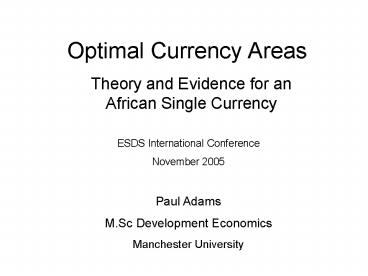Optimal Currency Areas - PowerPoint PPT Presentation
1 / 16
Title: Optimal Currency Areas
1
Optimal Currency Areas
- Theory and Evidence for an African Single Currency
ESDS International Conference November 2005 Paul
Adams M.Sc Development Economics Manchester
University
2
Objectives of Presentation
- To present my findings regarding an African
Single Currency - To highlight the importance of international
datasets for this paper - To indicate data gaps which I found whilst
undertaking this research - Re-affirm the importance of reliable data for
developing countries
3
The Theoretical Backdrop
- Mundell (1961) and McKinnon (1963) begin the
debate on the size of Optimal Currency Areas
(OCAs) - Central concept of asymmetric shocks and labour
mobility - Many theoretical advancements, often from
unexpected areas of economics - Impending European Monetary Union saw a more
rigorously empirical approach to OCA theory - See Tavlas (1993) for a thorough overview
4
The African Backdrop
- Single currency a political aim since 1963 when
the Organisation for African Unity was founded - Renewed emphasis since the Abuja Treaty in 1994
- Tito Mboweni, Governor of the South African
Central Bank, now indicates 2021 as the target
date for monetary integration - Poor intra African trade levels just 10 of
total African trade
5
African Data Problems
- Relatively large area to assess
- 53 countries compared to 15 originally in EU
- Mostly constituent of developing nations
- More straightforward economic indicators only
reliably available since the 1980s - Certain countries have no economic data
- More complex financial data still missing for
many countries
6
The Way Forward
- Objective
- An assessment of regional economic communities to
remove duplication - Investigation into the possible trade effects of
monetary integration in Africa
- Solution
- An OCA Index to predict convergence of average
bilateral exchange rates within groups - A Gravity Model of intra-African trade
7
Regional Economic Communities
ECOWAS Economic Community of West African
States COMESA Common Market for Eastern and
Southern Africa ECCAS Economic Community of
Central African States SADC Southern African
Development Community AMU United Maghreb Arab
8
Successive Allocation to Regional Economic
Communities
Stage Country REC Chosen (Rejected)
1 Mauritius SADC (COMESA)
2 Congo, Democratic Republic ECCAS (COMESA, SADC)
3 Angola SADC (COMESA)
4 Seychelles COMESA (SADC)
5 Zambia SADC (COMESA)
6 Burundi ECCAS (COMESA)
7 Zimbabwe COMESA (SADC)
8 Malawi SADC (COMESA)
9 Rwanda ECCAS (COMESA)
9
Gravity Model RationaleThings that effect trade
- Common colonial history
- Common nationality
- Shared language
- Geographical distance
- Geographical size
- Economic Size
- Population
- Island Status
- Landlocked Status
- Membership in Customs Unions
- Membership in economic communities
- Common currency
10
The Scary Bit Or, Gravity Model Estimation
- The estimating equation
- The simple explanation
- Countries trade for various reasons, the gravity
model seeks to include as many of these as
possible. - Specifically, the variable of interest is CU the
currency union variable - Accounting for all these variables, does
membership in a single currency increase trade
11
Gravity Analysis Data requirements and sources
Real Bilateral Trade International Monetary Fund Direction of Trade Statistics
Population World Bank World Development Indicators
Real GDP World Bank World Development Indicators
Other geographic and political dummies Mostly CIA World Factbook
12
Estimates of the Currency Union Effect on
Intra-African Trade
Pooled Panel OLS with robust Standard errors 3.27
Time-Fixed Effects 2.93
Other Estimates of the Currency Union Effect
Rose (2000) 1.21
Rose and Glick (2002) 1.3
Masson and Patillo (2005) 1.29
13
Time Series Data ProblemShort time scale
Equatorial Guinea CFA 1985 (entry)
Guinea Bissau CFA 1997 (entry)
Madagascar CFA 1982 (exit)
Mali CFA 1984 (entry)
14
Conclusions
- In general, the currency union effect on
intra-African trade is positive and significant - This was robust to a number of sensitivity tests
- The point estimate is of a similar magnitude to
comparable studies - There remains the need for further investigation
15
Epilogue The Search for Data
- The availability of data has been instrumental in
expanding the OCA debate into more empirical
areas. - The dissemination of good data practices needs to
continue in developing countries - To act as a real-time monitor
- To enable detailed research which benefit from
longer and wider datasets. - PARIS21 spreading this message
- Ability of data to form a virtuous circle with
development.
16
The Virtuous Circle
? Data
? Research
? Growth/Development
? Quality of Policy Decisions































